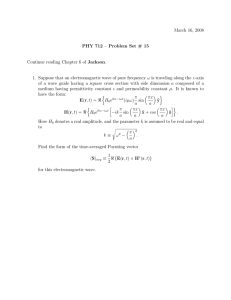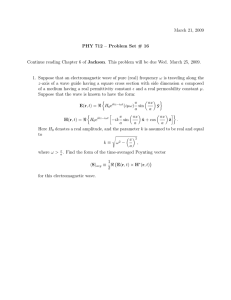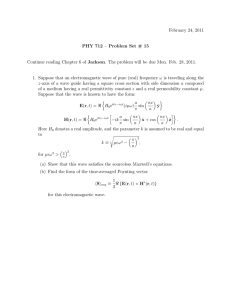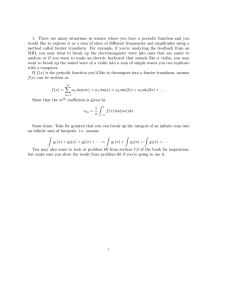y(x,t)=y sin( kx
advertisement
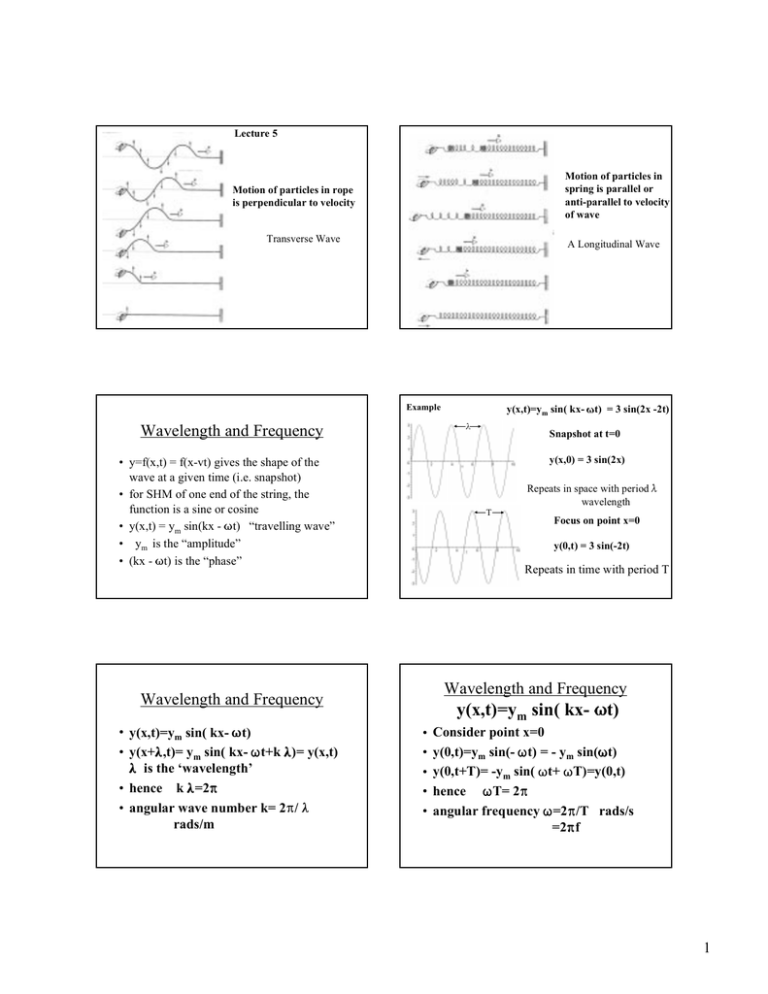
Lecture 5 Motion of particles in spring is parallel or anti-parallel to velocity of wave Motion of particles in rope is perpendicular to velocity Transverse Wave A Longitudinal Wave y(x,t)=ym sin( kx- 7t) = 3 sin(2x -2t) Example Wavelength and Frequency y(x,0) = 3 sin(2x) • y=f(x,t) = f(x-vt) gives the shape of the wave at a given time (i.e. snapshot) • for SHM of one end of the string, the function is a sine or cosine • y(x,t) = ym sin(kx - 7t) “travelling wave” • ym is the “amplitude” • (kx - 7t) is the “phase” Repeats in space with period wavelength T Focus on point x=0 y(0,t) = 3 sin(-2t) Repeats in time with period T Wavelength and Frequency y(x,t)=ym sin( kx- 7t) Wavelength and Frequency • y(x,t)=ym sin( kx- 7t) • y(x+,t)= ym sin( kx- 7t+k )= y(x,t) is the ‘wavelength’ • hence k =2% • angular wave number k= 2%/ rads/m Snapshot at t=0 • • • • • Consider point x=0 y(0,t)=ym sin(- 7t) = - ym sin(7t) y(0,t+T)= -ym sin( 7t+ 7T)=y(0,t) hence 7T= 2% angular frequency 7=2%/T rads/s =2%f 1 Consider two snapshots of the wave taken t apart Speed • y(x,t)=ym sin( kx- 7t) • rewrite as y(x,t)=ym sin[ k(x- (7/k)t)] • general form of wave travelling to the right is f(x-vt) • hence v = 7/k • 7= v k 1 2 The phase of the two points is the same since y is the same kx1-7t1 = kx2- 7t2 7(t2 -t1) = k(x2 -x1) If t2>t1 then x2>x1 As t <0, v =x/ t < 7/k Summary Chapter 17 Problem 12 • 7 = 2%f = 2%/T k= 2%/ • v = 7/k = f = /T • wave speed= one wavelength per period • y(x,t)=ym sin( kx- 7t) describes a wave moving right at constant speed v= 7/k • kx- 7t = const labels a point on the wave x = (7/k) t + const • y(x,t)=ym sin( kx+ 7t) is a wave moving left • kx+ 7t = const labels a point on the wave x = -(7/k) t + const • The equation of a transverse wave travelling on a string is • y(x,t) = 6.0 sin (0.020 %x + 4.0 %t) where x is in cm, y is in cm and t in seconds • (a) amplitude? • ym = 6.0 cm • (b) wavelength? • k=2%/ = .02 % = .01 (2%) hence =100 cm • (c) frequency? • 7= 4.0 % = 2%f hence f= 2 Hz Problem 12 Cont’d y(x,t) =6.0sin(0.020 %x + 4.0 %t) • • • • • speed? v= f = /T = (100cm)(2 Hz) = 200 cm/s direction? left maximum transverse speed of a particle in the string? • vy(x,t)= dy/dt = 24.0%cos(0.020%x +4.0 %t) vymax = 24.0 % cm/s Wave speed of a stretched string • Actual value of v = 7/k is determined by the medium • as wave passes, the “particles” in the medium oscillate • medium has both inertia (KE) and elasticity (PE) • dimensional argument: v= length/time LT-1 • inertia is the mass of an element =mass/length ML-1 • tension - is the elastic character (a force) MLT-2 • how can we combine tension and mass density to get units of speed? 2 Wave speed of a stretched string • v = C (-/)1/2 (MLT-2/ML-1)1/2 =L/T • detailed calculation using 2nd law yields C=1 v = (-/)1/2 • speed depends only on characteristics of string • independent of the frequency of the wave - f due to source that produced it • once f is determined by the generator, then • = v/f = vT 3

